Visa pilots Web3 customer loyalty platform
Crypto products and partnerships continue to emerge from the payments giant

Michael Vi/Shutterstock modified by Blockworks
Visa is releasing a Web3 loyalty service that involves gamified giveaways and immersive treasure hunts, the digital payments giant announced Thursday.
The customer engagement platform, named the Visa Web3 Loyalty Engagement Solution, will let brands create digital wallets where they can store reward points and experiences on behalf of consumers.
According to customer experience and loyalty management firm Bond’s The Loyalty Report, which interviewed over 60,000 consumers globally, many customers are looking to be rewarded for engaging and interacting with brands and not simply for purchasing their goods or services.
Specifically, the report noted that customers are more likely to build relationships with brands that they believe to share similar values with, and loyalty programs have yet to be able to utilize mechanics to integrate this type of alignment into their membership programs.
Kathleen Pierce-Gilmore, the SVP and global head of issuing solutions at Visa, noted in a press release reviewed by Blockworks that traditional loyalty programs have struggled to innovate and evolve over the past decade.
“Imagine earning a unique digital collectible, whether it’s from purchasing tickets for a sports event or participating in an augmented reality treasure hunt,” Pierce-Gilmore said.
She believes that Visa’s new loyalty solution — which has been designed in partnership with Web3 engagement and loyalty platform SmartMedia Technologies — will enable brands to provide digital wallets to their customers so that they earn perks and benefits, such as online or real-world experiences in travel, sports and entertainment, ultimately changing the loyalty experience that exists today.
“Our innovative Web3-based loyalty solution empowers brands to reward customers not only for their transactions but for their active engagement, paving the way for secure, seamless and immersive digital and real-world experiences at their fingertips,” Pierce-Gilmore said.
Visa has long had a presence in crypto. In 2021, the firm launched a crypto advisory unit to help its clients and partners navigate the space. At the time, Visa cited crypto rewards programs as a possible offering for which it could consult.
Visa has a deep roster of existing crypto partners and projects. It has card programs with a slew of exchanges, began settling transactions in USDC as early as 2020 and, more recently, started allowing partners to send or receive USDC payments via the Solana blockchain.
The credit card giant is not the only one looking into re-shaping rewards using Web3, but by dipping its toes into the tech for customer loyalty, Visa opens a use case that has been ideated for some time but has seen limited adoption.
Recently, Circle helped debut a points-to-crypto scheme for Taiwanese convenience store chain FamilyMart, and Starbucks is still accepting waitlist entries for its NFT-enabled Odyssey rewards program.
Get the news in your inbox. Explore Blockworks newsletters:
- The Breakdown: Decoding crypto and the markets. Daily.
- 0xResearch: Alpha in your inbox. Think like an analyst.






